High material waste, slow cycle times, and inconsistent part quality eating into your profits? You know there’s a better way than traditional cold runner systems, but the world of hot runners can seem complex and expensive. Understanding the types, benefits, and selection criteria of hot runner systems can unlock massive efficiency gains and deliver a higher quality product, boosting your bottom line.
A hot runner system is a heated assembly used in plastic injection molds that keeps the molten plastic hot as it flows from the machine nozzle to the mold cavities. This eliminates the solid runner, which is waste material in a cold runner system. Key selection criteria include the type of plastic resin, part design complexity, required production volume, and budget. Choosing correctly reduces cycle times, saves material, improves part quality, and offers greater design flexibility for your projects.
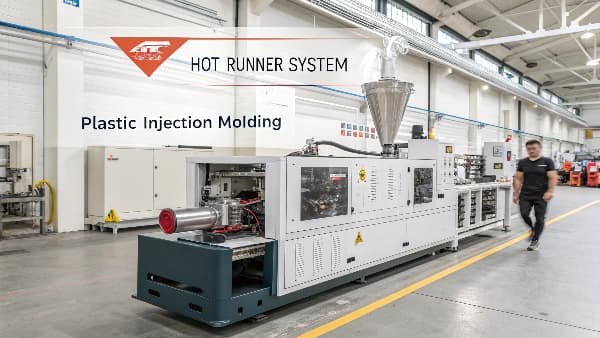
Now that we have a basic idea, you might be wondering what this all means for your company’s efficiency and profitability. This technology is more than just a component; it’s a strategic choice that can redefine your manufacturing process. Let’s dive deeper into how these systems work, the different types available, and why one might be the best investment you make for your production line.
What Exactly Is a Hot Runner System and How Does It Differ From a Cold Runner?
You hear terms like "hot runner" and "cold runner" but aren’t sure of the fundamental difference or why it matters for your operations? This uncertainty can lead to costly decisions or missed opportunities for optimization in your molding process. Let’s clarify the core concepts so you can confidently evaluate which system is right for your production needs and make an informed decision for your next project.
A hot runner system uses a heated manifold and nozzles to keep plastic in a molten state all the way to the part cavity. In contrast, a cold runner is simply an unheated channel in the mold. The plastic in a cold runner solidifies with the part and must be ejected, often becoming waste. The key difference is that hot runners eliminate this sprue and runner waste, enabling faster cycles, saving significant material costs, and improving overall process control.
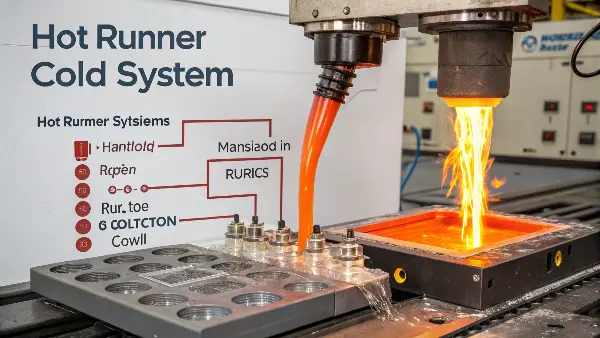
To really grasp the impact, let’s break it down further. In my early days in the factory, I saw firsthand the limitations of cold runner systems.
The Cold Runner System
A cold runner is the simplest way to get plastic into the mold cavity. It’s just a channel carved into the mold plates. After the molten plastic is injected, the plastic in the part, the gate, and the runner all cool down and solidify together. The entire shot, including the solidified runner, is then ejected.
There are two main types:
- Two-Plate Molds: The runner is on the same parting line as the part. When the mold opens, the runner is ejected along with the parts. This runner then needs to be manually or robotically separated, which adds a step to the process.
- Three-Plate Molds: This design has an extra plate that allows the runner to be separated from the parts automatically as the mold opens. It’s more complex than a two-plate mold but simplifies the post-molding process.
The big takeaway for cold runners is that the runner itself is waste material. While some thermoplastics can be reground and reused, this adds labor, energy costs, and can degrade the material properties.
The Hot Runner System
A hot runner system, on the other hand, is like a dedicated, heated plumbing system inside your mold. It consists of a heated manifold that distributes the plastic and heated nozzles that deliver it directly into the cavities. Because the entire system is kept at the plastic’s melting temperature, the runner never solidifies. Only the part itself cools and is ejected. This is the magic of the hot runner. It’s a fundamental shift from treating the runner as disposable to treating it as part of the machine.
Here’s a simple comparison:
| Feature | Cold Runner System | Hot Runner System |
|---|---|---|
| Material Waste | High (runner is waste/regrind) | Virtually none |
| Cycle Time | Slower (runner needs to cool) | Faster (only part needs to cool) |
| Initial Cost | Low | High |
| Maintenance | Simple | More complex |
| Gate Location | Limited by runner path | Highly flexible |
| Part Quality | Can have gate blemishes, sink marks | High consistency, better cosmetics |
What Are the Main Types of Hot Runner Systems Available?
You’ve decided a hot runner might be the solution, but now you’re faced with a confusing array of types like "hot tip," "valve gate," and "externally heated." Choosing the wrong one could negate the benefits and lead to cosmetic defects or processing issues with your parts. Understanding the primary categories and their variations will empower you to select the perfect system for your material and part requirements.
The two main types are externally heated and internally heated systems. Externally heated systems are more common and robust, ideal for many commodity resins. Internally heated systems offer better temperature control, making them suitable for heat-sensitive polymers. Within these, the gating method is crucial: an open gate (or hot tip) is simpler and cost-effective, while a valve gate system uses a mechanical pin to provide precise flow control and a clean gate mark, making it ideal for high-cosmetic parts.
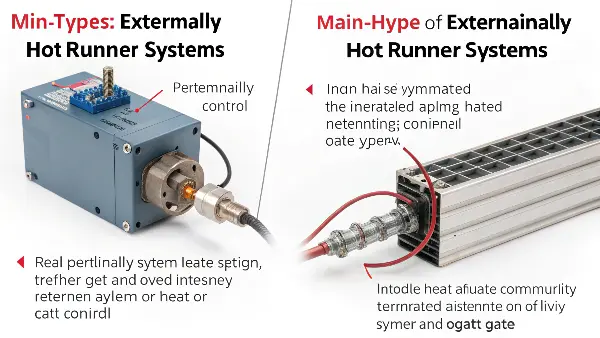
Choosing the right type is critical. I once worked with a client, let’s call him Michael, who was producing a sleek housing for a consumer electronic device. He initially opted for a simpler system to save on cost, but it left a small blemish at the gate point. For his high-end product, this was unacceptable. We had to switch systems, which cost time and money. Let’s make sure you don’t make the same mistake by understanding the main options.
Gating Method: The Most Important Choice
The way the plastic enters the cavity (the "gate") is the most significant differentiator for your part’s quality.
-
Open Gate (or Hot Tip) Systems: This is the simpler of the two main gate types. The nozzle has an open hole that is always in contact with the part cavity. The flow of plastic is controlled by pressure and by the plastic freezing off at the small gate opening at the end of the cycle. They are cost-effective and work well for many common plastics like polypropylene (PP) and polyethylene (PE). However, they can sometimes leave a small nub or string on the part, which might not be suitable for cosmetic surfaces.
-
Valve Gate Systems: This is the premium option. A valve gate system has a mechanical pin that actively opens and closes the gate. When the mold is filled, the pin moves forward to shut off the flow of plastic completely before it solidifies. This provides incredibly precise control over the filling process and leaves a very clean, smooth gate mark on the part. It’s the go-to choice for applications demanding perfect aesthetics, like automotive lenses, clear medical devices, and high-end consumer electronics. They are also excellent for preventing drooling with low-viscosity materials.
Heating Method: Less Common but Still Relevant
While the gating method is your primary concern, it’s good to know how these systems are heated.
- Externally Heated Systems: This is the industry standard. The heater is on the outside of the flow channel, like a jacket. This design is robust, provides uniform heat, and is easier to maintain. It’s a workhorse suitable for the vast majority of applications.
- Internally Heated Systems: Here, the heating element is inside the flow channel, like a torpedo. This offers very direct and responsive temperature control, which is great for thermally sensitive plastics that can degrade easily, like PVC or PET. However, they can create flow lines in the material and are generally more complex to maintain.
For most business owners like Michael, the choice will boil down to Hot Tip vs. Valve Gate. Your decision here will directly impact part quality and cost.
What Are the Real-World Benefits of Investing in a Hot Runner System?
The initial cost of a hot runner system is significantly higher than a cold runner. As a business owner, you absolutely need to justify this investment with tangible returns. Without a clear understanding of the benefits, it’s hard to convince stakeholders or yourself that the upfront expense is worth it. Let’s break down the specific, measurable advantages that hot runner systems bring to your production floor and your balance sheet.
The primary benefits of a hot runner system are significant cost savings and improved efficiency. This comes from eliminating material waste (no runners to regrind or discard), reducing cycle times as there’s no runner to cool, and lowering energy consumption. Additionally, they provide better process control, leading to superior part consistency and quality. The design flexibility also increases, allowing for more complex part geometries and multiple gating points.
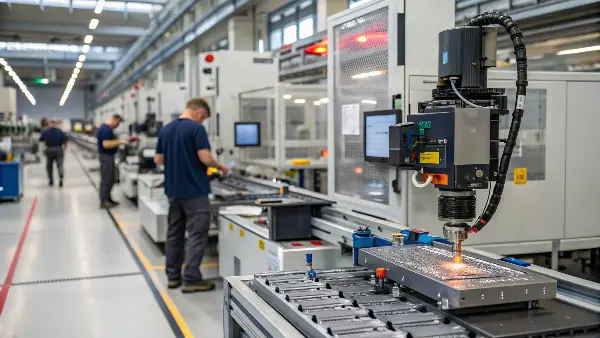
When I started my own company, every dollar mattered. I was hesitant to spend on expensive hot runner molds. But after my first project using one, the numbers spoke for themselves. The ROI wasn’t just theoretical; it was clear on the production reports and in the bank account. Here’s a deeper look at the advantages you can expect.
1. Massive Material Savings
This is the most direct financial benefit. A cold runner can account for anywhere from 5% to 50% of the total shot weight. With a hot runner, that material stays in the system, ready for the next shot. Imagine you’re running a part with a 50-gram runner on a 1-million-part run. That’s 50,000 kilograms of plastic you don’t have to buy. Even if you regrind, you’re saving on the energy to granulate, the labor to handle it, and you’re avoiding the quality loss that comes with using regrind. For expensive engineering-grade polymers, the savings are astronomical.
2. Reduced Cycle Time
In injection molding, time is money. A huge portion of the cycle is dedicated to cooling. A cold runner is often the thickest part of the shot, meaning it dictates the cooling time. By eliminating the runner, you only need to cool the part itself. This can slash cycle times by 15-30% or even more. Faster cycles mean more parts per hour, which increases your capacity and lowers the cost per part.
3. Improved Part Quality and Consistency
Hot runner systems give you incredible process control.
- Consistent Filling: The melt is delivered to each cavity at a more uniform temperature and pressure, which is critical for multi-cavity molds. This results in more consistent part weight, dimensions, and performance.
- Better Aesthetics: Valve gates, in particular, eliminate the ugly gate vestige left by many cold runner systems. You get a clean, smooth surface right out of the mold.
- Reduced Molded-in Stress: Because the plastic flows more gently and at a more consistent temperature, there is less stress locked into the part. This leads to better structural integrity and less warpage.
4. Greater Design Freedom and Automation
Without the physical constraints of a cold runner, you can place gates in the ideal location for part filling and function, not just where it’s convenient. This allows for more complex and innovative part designs. Furthermore, because parts are ejected without an attached runner, the process is perfect for full automation. Parts can drop directly onto a conveyor belt for packaging, eliminating the need for a secondary runner-separation step.
How Do You Select the Perfect Hot Runner System for Your Project?
You understand the types and benefits, but how do you translate that knowledge into making the right choice for a specific part and material? Making a poor selection can lead to production nightmares, missed deadlines, and a system that fails to deliver its promised ROI. By following a structured selection process, you can confidently choose a hot runner system that is perfectly matched to your application’s unique demands.
To select the right hot runner, first analyze your plastic material; its viscosity and processing temperature window are critical. Next, consider the part’s design, including its size, weight, and cosmetic requirements. The production volume and required cycle time will also influence the choice. Finally, balance the initial investment cost against the long-term savings in material and efficiency. Engaging with an experienced supplier like us at CKMOLD early in the design phase is crucial for making the optimal decision.
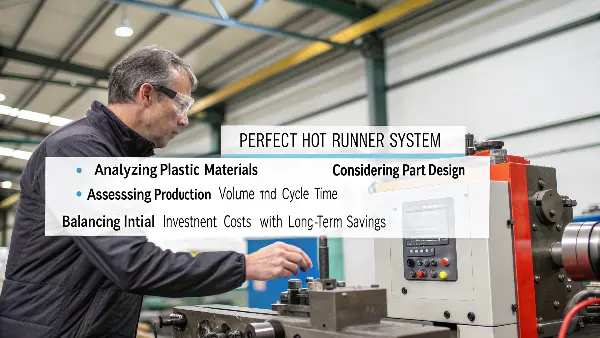
Choosing a hot runner isn’t like picking a part off a shelf. It’s a collaborative engineering decision. I always tell my clients to think of it as a partnership. You bring the project requirements, and we bring the molding expertise. Together, we can specify a system that works flawlessly. Here are the key factors we would discuss.
1. Plastic Material Properties
This is your starting point. The resin dictates everything.
- Processing Temperature: Does the material have a wide or narrow processing window? Heat-sensitive materials like PVC or PET might require a more sophisticated system with better temperature control (like an internally heated or valve gate system) to prevent degradation.
- Viscosity (Melt Flow): Low-viscosity, free-flowing materials like nylon are prone to "drooling" from an open gate nozzle. A valve gate is almost always necessary to prevent this. High-viscosity materials require larger flow channels and sufficient pressure to fill properly.
- Additives: Is the material filled with glass fibers or other abrasive fillers? This will cause wear and tear. You’ll need nozzles made from hardened tool steels to withstand the abrasion. Corrosive materials like PVC require stainless steel components.
2. Part Design and Quality Requirements
Next, we look at the part itself.
- Part Weight and Size: Larger, heavier parts require larger nozzle orifices and flow channels to allow for faster filling and reduced shear stress on the material.
- Wall Thickness: Thin-walled parts require fast injection speeds and high pressure, which the hot runner must be able to accommodate without causing excessive shear heat.
- Cosmetic Requirements: Is the gate mark visible on the final product? If aesthetics are critical, a valve gate is the only real option. It provides the cleanest possible gate mark. For a hidden internal part, a more economical hot tip might be perfectly fine.
3. Production and Mold Considerations
Finally, we look at the bigger picture.
- Number of Cavities: For high-cavitation molds, ensuring a balanced flow to every single cavity is essential for part consistency. A well-designed hot runner manifold is key to achieving this.
- Cycle Time Goals: If maximum speed is your primary goal, the system needs to be designed to facilitate rapid filling and minimal cooling time.
- Budget vs. ROI: A valve gate system can cost twice as much as a hot tip system. You need to calculate the ROI. If the material savings and quality improvements justify the cost over the life of the project, it’s a wise investment. Don’t let the initial price tag scare you away from the better long-term solution.
What Common Challenges Can Arise with Hot Runners and How Do You Prevent Them?
Hot runner systems are powerful but also complex, introducing potential points of failure that can halt production. A leaking nozzle, a burnt-out heater, or cosmetic issues can cause significant downtime and costly repairs, ruining your schedule and budget. By understanding the common pitfalls and implementing preventative strategies, you can ensure your hot runner system operates reliably for years to come.
Common challenges include gate drooling or stringing, nozzle leakage, and heater failure. Drooling and stringing are often solved by optimizing temperature settings or using a valve gate. Nozzle leakage is prevented by ensuring correct installation torque and accounting for thermal expansion. Heater failure is minimized by using high-quality components and avoiding contamination. A robust preventative maintenance schedule is the best defense against unexpected downtime.
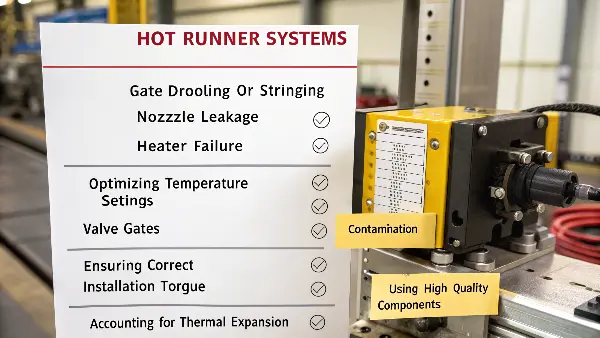
I’ve seen it happen: a company invests heavily in a state-of-the-art hot runner mold, but a small, preventable issue brings their multi-million dollar production line to a standstill. These systems are not "set it and forget it." They are high-performance machines that require attention and care. Knowing what to watch for is half the battle.
Challenge: Cosmetic Gate Issues (Drooling, Stringing, Vestige)
This is one of the most frequent problems.
- Problem: Drooling is when a small amount of plastic leaks out of the nozzle tip before injection, creating a blemish. Stringing is when a thin thread of plastic is pulled from the gate as the part ejects. A large vestige is the "nub" left behind at the gate point.
- Prevention and Solution: For drooling with open gate systems, you can try lowering the nozzle temperature or using decompression (suck-back) on the injection molding machine. However, the most reliable solution is to use a valve gate system. The mechanical shut-off physically prevents any unwanted leakage. Proper gate cooling is also essential to ensure the plastic at the gate freezes off cleanly and quickly.
Challenge: Plastic Leakage at the Manifold or Nozzles
This is the most dangerous and costly failure.
- Problem: Molten plastic leaks out between the nozzle and the manifold, or between the manifold and the mold plate. This can encase heaters and thermocouples, causing catastrophic damage that requires a complete system teardown and cleaning, which means days of downtime.
- Prevention and Solution: This is almost always an assembly or design issue. It’s critical that thermal expansion is calculated correctly. The system is assembled cold, but operates at hundreds of degrees. The components must be designed to seal tightly at operating temperature. Following the manufacturer’s torque specifications for bolts is non-negotiable. I once had a client whose maintenance team assembled a mold without a torque wrench, leading to a massive leak that cost them tens of thousands in repairs and lost production.
Challenge: Heater or Thermocouple Failure
This can cause mysterious quality problems or stop production entirely.
- Problem: A heater burns out, or a thermocouple (which measures temperature) fails or gives an inaccurate reading. This leads to cold slugs of plastic, inconsistent filling, or overheating and degrading the material.
- Prevention and Solution: First, invest in high-quality components from reputable suppliers. Cheaper heaters burn out faster. Second, prevent contamination. During installation, ensure no moisture, oil, or plastic residue gets on the heater leads, as this can cause a short circuit. A regular preventative maintenance schedule should include checking the resistance of all heaters and verifying thermocouple readings to catch problems before they cause a shutdown.
Conclusion
Choosing to use a hot runner system is a major step toward a more efficient and profitable injection molding operation. While the initial investment is higher than a traditional cold runner, the long-term returns from material savings, faster cycle times, and superior part quality are undeniable. The key is to make an informed choice by carefully analyzing your material, part design, and production needs. Don’t be afraid to invest in the right technology, like a valve gate system, if your quality standards demand it.
